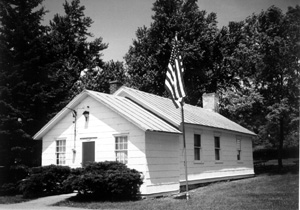|
Even With Just One Room, Much Learning Happened at this School
by Alex Lee, age 14 and Rosalinda Villegas, age 14

When we think of schools today, we generally think of large buildings filled with hundreds of students. On a recent visit to a one-room school house, we were reminded there was a time when schools were not so populous. We spent the day learning what it was like to attend the Old Halfway Prairie School House, a school that was founded in 1848. Now it’s a museum. Our gracious hosts were Darlene Grover, a former student and her teacher, Cleo Brockman.
Cleo Brockman was the sole school employee. As such, she served as the regular teacher, nurse, music teacher, art teacher, and principal all at once.
At 9:00 A.M. each day a class of about 25 students ranging from grades one through eight began their school day. The kids tied their books together with a belt and hung them on their “lockers,” which consisted of hooks on the walls in the front of the room. They also carried with them tin pails containing their lunches from home.
Each desk in the room had a hole for an inkwell, which held ink for the students to dip pens. They used slates and tablets of rough paper to write on. Their desks were small in the front, but gradually toward the back of the room, the desks were larger. A Franklin wood stove sat in the front of the room, keeping the classroom warm during cold winters. The teacher, Cleo, rang a bell every day to get the students’ attention so she could start class.
Cleo taught math, reading, penmanship, music, spelling, geography, history, and physical education. Each subject was taught for only 15 minutes because she had many grade levels to teach. She began the day by teaching first through third grades, and then taught fourth through sixth and finally seventh and eighth. A typical school day, for example, started with first 10:00 A.M. to 10:15 A.M. These grades worked silently while other grades were being taught. After that, it was third and fourth grade reading time.
While Cleo taught, the older children helped the younger ones. This seemed to us similar to what w do at the Simpson Street Free Press. While older students engaged in lessons, the younger students were able “learn ahead” by reading or working independently. It was hard for us to imagine 25 students fitting into such a small room and learning so many different subjects.
Cleo also emphasized the importance of penmanship. Penmanship was very important back then because job applicants were judged on spelling, legibility and grammar.
During recess, kids had choices of a slide or one ball and a bat. Naughty children were not permitted to go outside.
Every year, the school orchestrated a Christmas program, in which the children acted and sang for the community. Because the school was the center of community, all important events were held there. Back then, they didn’t have a summer vacation like we do today. Kids had school vacation only during Thanksgiving and Christmas. They didn’t look forward to vacation as much as we do today. This is probably because it meant it was time to work on the farm, helping their parents.
Every student was assigned his or her own classroom job. Some of the jobs were to fill the water bubbler, sweep out the toilets, clap the chalkboard erasers and most importantly, raise the flag. Raising the flag was a responsibility and an honor. You could not drag the flag or get it wet. If it rained, it was the obligation of students who to lower it and bring it inside.
At the beginning of every year, the school board would decide how much each family would pay for tuition. It usually cost about two dollars per student for each school year. Families also supplied the firewood. Everyone contributed to the school in one way or another.
We learned many things at the Old Halfway School House. It was clear to us that Cleo’s students liked and respected her; nowadays, we feel that many students don’t treat their teachers with that same respect. We were able to see up close and first-hand a picture of the one room school taken 50 years ago. It was amazing how well the school has been preserved by its teacher, former student, and other volunteers. These volunteers deserve our thanks for preserving such an important part of our history.
We really enjoyed this experience and learned much about how schools have changed over the years. We know how lucky we are to have such excellent schools today. And now, after visiting the Old Halfway Prairie School, we also realize that learning depends on people—not necessarily big buildings.
|

